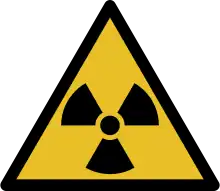Atomic semiotics
Atomic semiotics (or nuclear semiotics) is an interdisciplinary field of semiotics which studies potential uses of long-term nuclear waste warning messages. It is concerned with labelling radioactive waste to deter human intrusion at nuclear waste repositories in the far future.

Entrance of Yucca Mountain

Currently used warning sign for Radioactivity, W05: "Warning of radioactive substances or ionizing radiation“

ISO 21482 warning used since 2007, which is more explicit
Elements of the message
The message must contain three elements:
- That it is a message
- That the substances put in a specific place are dangerous
- Information about the kind of danger which comes from these substances
The message must also be credible. If it isn't credible it will be understood, but neglected; people will believe that this is done to protect an important treasure. These substances must be safe for 10.000s to millions of years.
This article is issued from Wikipedia. The text is licensed under Creative Commons - Attribution - Sharealike. Additional terms may apply for the media files.